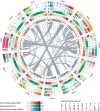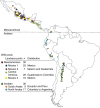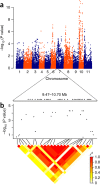A reference genome for common bean and genome-wide analysis of dual domestications
- PMID: 24908249
- PMCID: PMC7048698
- DOI: 10.1038/ng.3008
A reference genome for common bean and genome-wide analysis of dual domestications
Abstract
Common bean (Phaseolus vulgaris L.) is the most important grain legume for human consumption and has a role in sustainable agriculture owing to its ability to fix atmospheric nitrogen. We assembled 473 Mb of the 587-Mb genome and genetically anchored 98% of this sequence in 11 chromosome-scale pseudomolecules. We compared the genome for the common bean against the soybean genome to find changes in soybean resulting from polyploidy. Using resequencing of 60 wild individuals and 100 landraces from the genetically differentiated Mesoamerican and Andean gene pools, we confirmed 2 independent domestications from genetic pools that diverged before human colonization. Less than 10% of the 74 Mb of sequence putatively involved in domestication was shared by the two domestication events. We identified a set of genes linked with increased leaf and seed size and combined these results with quantitative trait locus data from Mesoamerican cultivars. Genes affected by domestication may be useful for genomics-enabled crop improvement.
Conflict of interest statement
The authors declare no competing financial interests.
Figures





Comment in
-
The complex domestication history of the common bean.Nat Genet. 2014 Jul;46(7):663-4. doi: 10.1038/ng.3017. Nat Genet. 2014. PMID: 24965727
References
-
- Anderson JW, et al. Hypocholesterolemic effects of oat-bran or bean intake for hypercholesterolemic men. Am. J. Clin. Nutr. 1984;40:1146–1155. - PubMed
-
- Geil P, Anderson J. Nutrition and health implications of dry beans: a review. J. Am. Coll. Nutr. 1994;13:549–558. - PubMed
-
- Cichy KA, Caldas GV, Snapp SS, Blair MW. QTL analysis of seed iron, zinc, and phosphorus levels in an Andean bean population. Crop Sci. 2009;49:1742–1750.
-
- Beebe S. Common bean breeding in the tropics. Plant Breed. Rev. 2012;36:357–426.
Publication types
MeSH terms
Associated data
- Actions
LinkOut - more resources
Full Text Sources
Other Literature Sources
Miscellaneous

